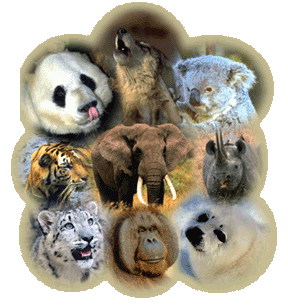So it has come down to this? I sure hope not, but since we seem completely unable to get up off our asses and save this planet, many would tell you, there is simply no choice than to triage which species get to live (for now) and which species get thrown into the dust bin.
I hate it and I won't endorse it.
What can I tell you. I have no answers. In the end, we are on our way to join those who don't get picked anyway. Trouble is we are still here and will be here for a while and will continue to destroy everything in our path for profit. Isn't that what it comes down to, after all? Some people, some capitalists have to make more money, have to accumulate more capital. Hell, you can't have capital without capitalist accumulation and we seem incapable or unwilling to really get rid of it, so we are just signing death warrants.
That is what we are doing.
Anyway, there was an article in Scientific Americans this month about this, but I can't find a way to download the whole thing and post it, so I am posting another article which seems to me to be a simplified version of the SA article, and a slide show from Scientific American related to their article.
I am not going to comment on the contents of either. Just presenting them here as a horrible example of where we are.
The first article below comes from Discovery News. The second post is from Scientific American.
WHICH SPECIES MUST DIE?

- Analysis by Sarah Simpson
Wed Jul 18, 2012 05:00 AM ET
(6) Comments | Leave a Comment
Looks like you’re on your own, rockhopper penguins. If you can’t wing it in this world alone, we’ll just have to say adieu. The costly, long-shot measures needed to protect you are more than most cash-strapped conservation organizations can justify.
Same goes to you, Chinese water dolphins. You’re cute and all, but you really serve no meaningful role in your ecosystem. Not compared to, say, gray wolves—top predators that control animal populations—or whitebark pines, critical food for grizzly bears. Now they’re worth saving.
And so long, mangrove forests. Sure, you provide a critical role in protecting coastlines, by trapping sediment and slowing the flow of water, but you don’t have much going on otherwise. Sequoia forests, on the other hand, those are rich biodiversity hotspots. They house all manner of unique plants and animals—definitely worth the investment…
Believe it or not, there is method to this madness. In the August 2012 issue of Scientific American, Colorado-based journalist Michelle Nijhuis investigates some of the new systems of triage that scientists are using determine which species to save and which to leave to die.
This reality is a stomach turner, but conservation groups can no longer afford to try to protect as many plants and animals as they did in the past. As budgets shrink and environmental stresses grow, politicians continue to prioritize the economy over the environment.
Bottom line: When you can’t save them all, you are forced to play god.
Nijhuis describes three ways that scientists and conservation organizations are making these tough decisions:
- The Chinese river dolphins lose out in so-called function-first approaches, which favor threatened species with a unique role in nature.
- Another strategy, which Nijhuis dubs “evolution first,” seeks to preserve genetic diversity, which can help all species to survive in fast-changing environments. Two-humped Bactrian camels and long-beaked echidnas are winners in this game. Gunnison sage grouses are losers; they are too closely related to other grouse species.
- The third approach, hotspots, focuses on saving whole ecosystems. It combines elements of the other two, but it still has winners and losers. (So sorry, mangrove forests).
Don’t imagine for a second that conservation triage is something entirely new:
"Conservationists who are pushing for explicit triage say they are bringing more systematic thinking and transparency to practices that have been carried out implicitly for a long time. 'The way we’re doing it right now in the United States is the worst of all possible choices,' says Tim Male, a vice president at Defenders of Wildlife. 'It essentially reflects completely ad hoc prioritization.' Politically controversial species attract more funding, he says, as do species in heavily studied places: 'We live in a world of unconscious triage.'"
Okay, okay. We get it. But for many people, triage still feels like abandonment.
It also feels like giving up on the guiding principle of the 1973 Endangered Species Act, which stipulated eligibility for protection forall nonpest species. The article paraphrases that landmark act’s reasoning as the Noah Principle: “all species are fundamentally equal, and everything can and should be saved, regardless of its importance to humans.”
Nijhuis captures that spirit, be it idealistic or comforting, in her final declaration:
"Just as a battlefield medic works unstintingly to save lives, even while knowing that he or she cannot save them all, societies should still aspire to the Noah Principle—and stuff the ark to the brim."
++++++++++++++++++++++++++++++++++++++++++++++++++++++++++++++++++++++++++++++++++++++++
Which Species Will Live, Which Will Die? [Slide Show]
Conservation groups can no longer afford to try to protect all animals and plants, forcing heartbreaking choices
| July 23, 2012 | 8
Conservationists are reluctantly experimenting with three forms of triage to help them decide which species to try to save or not save. Each method has different priorities: "Function first" favors species that perform a unique job in nature. "Evolution first" seeks to preserve genetic diversity. "Hot spots" prefers ecosystems rich in species.
So which animals and plants would flourish or perish in each of the schemes?
See this slide show to find out
So which animals and plants would flourish or perish in each of the schemes?
See this slide show to find out



No comments:
Post a Comment